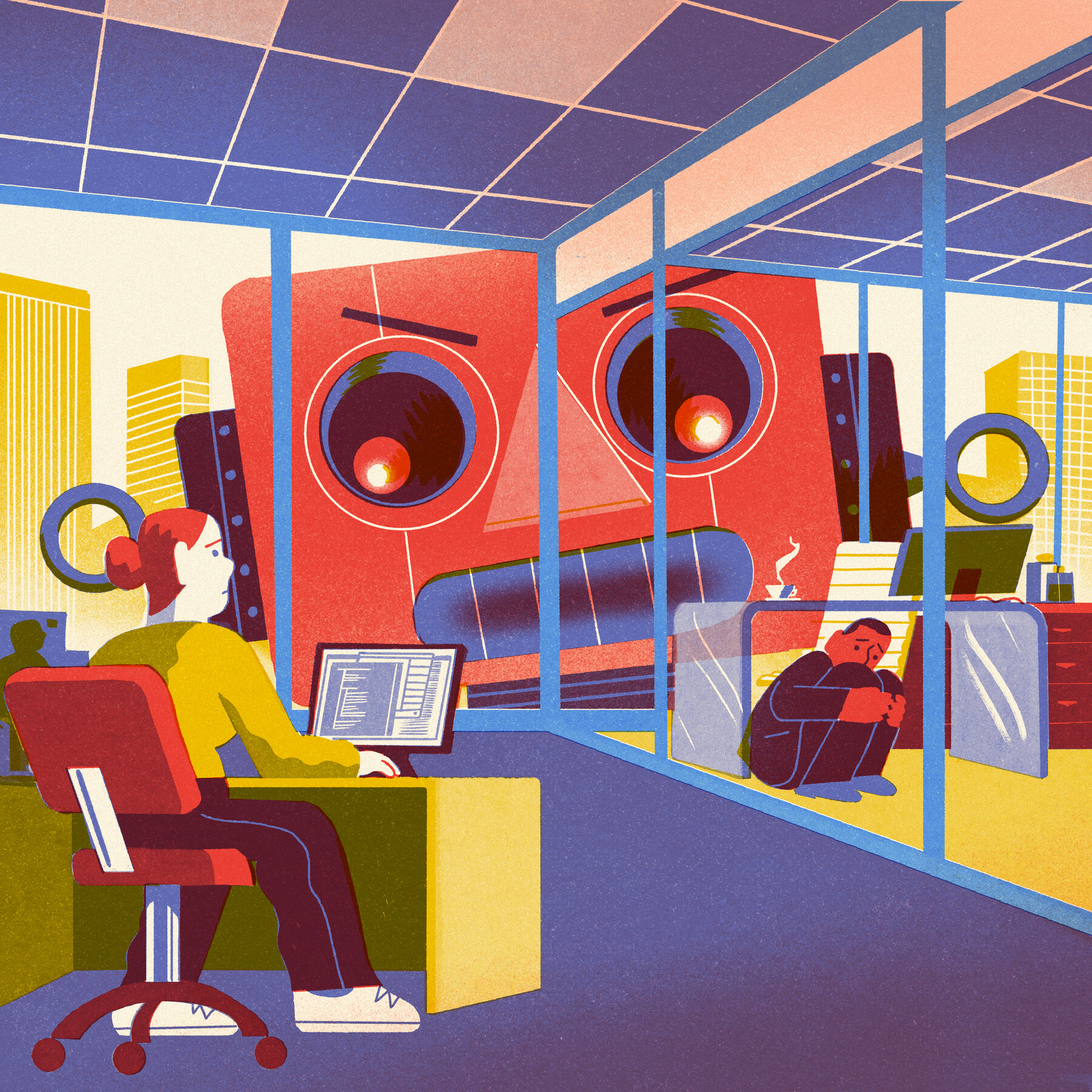

When Amazon’s chief executive, Andy Jassy, wrote last month that he expected the company’s use of artificial intelligence to “reduce our total work force” over the next few years, it confirmed the fear among many workers that A.I. would replace them. The fear was reinforced two weeks later when Microsoft said it was laying off about 9,000 people, roughly 4 percent of its work force.
That artificial intelligence is poised to displace white-collar workers is indisputable. But what kind of workers, exactly? Mr. Jassy’s announcement landed in the middle of a debate over just this question.
Some experts argue that A.I. is most likely to affect novice workers, whose tasks are generally simplest and therefore easiest to automate. Dario Amodei, the chief executive of the A.I. company Anthropic, recently told Axios that the technology could cannibalize half of all entry-level white-collar roles within five years. An uptick in the unemployment rate for recent college graduates has aggravated this concern, even if it doesn’t prove that A.I. is the cause of their job-market struggles.
But other captains of the A.I. industry have taken the opposite view, arguing that younger workers are likely to benefit from A.I. and that experienced workers will ultimately be more vulnerable. In an interview at a New York Times event in late June, Brad Lightcap, the chief operating officer of OpenAI, suggested that the technology could pose problems for “a class of worker that I think is more tenured, is more oriented toward a routine in a certain way of doing things.”
The ultimate answer to this question will have vast implications. If entry-level jobs are most at risk, it could require a rethinking of how we educate college students, or even the value of college itself. And if older workers are most at risk, it could lead to economic and even political instability as large-scale layoffs become a persistent feature of the labor market.
David Furlonger, a vice president at the research firm Gartner who helps oversee its survey of chief executives, has considered the implications if A.I. displaces more experienced workers.
“What are those people going to do? How will they be funded? What is the impact on tax revenue?” he said. “I imagine governments are thinking about that.”
Is A.I. Making Better Managers?
Economists and other experts who study A.I. often draw different conclusions about whom it’s more likely to displace.
Zooming in on the fields that have deployed A.I. most widely thus far tends to paint a dire picture for entry-level workers. Data from ADP, the payroll processing firm, shows that in computer-related fields, employment for workers with less than two years of tenure peaked in 2023 and is down about 20 to 25 percent since then. There is a similar pattern among customer service representatives, who are increasingly reliant on A.I. as well.
Over the same period, employment in these industries has increased for workers with two or more years of job tenure, according to Ruyu Chen, a Stanford researcher who analyzed the data.
Other studies point in a similar direction, if in a roundabout way. In early 2023, Italy temporarily banned ChatGPT, which software developers there relied on to help them code. A team of researchers at the University of California, Irvine, and Chapman University compared the change in the productivity of Italian coders with the productivity of coders in France and Portugal, which did not ban the software, to isolate the impact of ChatGPT.
While the study did not look at job loss, it did find that the A.I. tool had transformed the jobs of midlevel workers in more favorable ways than the jobs of entry-level workers. According to the researchers, the junior coders used A.I. to complete their tasks somewhat faster; the experienced coders often used it to benefit their teams more broadly. For example, the A.I. helped midlevel coders review the work of other coders and suggest improvements, and to contribute to projects in languages they didn’t know.
“When people are really good at things, what they end up doing is helping other people as opposed to working on their own projects,” said Sarah Bana, one of the paper’s authors, adding that the A.I. essentially reinforced this tendency. Dr. Bana said the paper’s result suggested that A.I. would prompt companies to hire fewer junior coders (because fewer would be needed to complete entry-level tasks) but more midlevel coders (because A.I. amplified their value to their whole team).
On the other hand, Danielle Li, an economist at M.I.T. who studies the use of A.I. in the workplace, said there were scenarios in which A.I. could undermine higher-skilled workers more than entry-level workers. The reason is that it can, in effect, untether valuable skills from the humans who have traditionally possessed them. For instance, you may no longer have to be an engineer to code, or a lawyer to write a legal brief.
“That state of the world is not good for experienced workers,” she said. “You’re being paid for the rarity of your skill, and what happens is that A.I. allows the skill to live outside of people.”
Dr. Li said A.I. would not necessarily be good for less experienced workers, either. But she speculated that the uptick in unemployment for new college graduates resulted from employers’ expectations that they will need fewer workers overall in the age of A.I., not just fewer novice workers. An overall hiring slowdown can have a bigger impact on workers right out of college, since they don’t have a job to begin with.
Robert Plotkin, a partner in a small law firm specializing in intellectual property, said A.I. had not affected his firm’s need for lower-skilled workers like paralegals, who format the documents that his firm submits to the patent office. But his firm now uses roughly half as many contract lawyers, including some with several years of experience, as it used a few years ago, before the availability of generative A.I., he added.
These more senior lawyers draft patent applications for clients, which Mr. Plotkin then reviews and asks them to revise. But he can often draft applications more efficiently with the help of an A.I. assistant, except when the patent involves a field of science or technology that he is unfamiliar with.
“I’ve become very efficient at using A.I. as a tool to help me draft applications in a way that’s reduced our need for contract lawyers,” Mr. Plotkin said.
Some of the companies at the cutting edge of A.I. adoption appear to have made similar calculations, laying off experienced employees rather than simply hiring fewer entry-level workers. Google, Meta and Amazon have all done layoffs since 2022. Two months before its most recent layoff announcement, Microsoft laid off 6,000 employees, many of them software developers, while the July layoffs included many middle managers.
“Anything that is administrative, spreadsheet-related, where there’s an email trail, a document-management type activity, A.I. should be able to perform fairly easily, freeing up time for managers to do more mentoring,” said Mr. Furlonger, the analyst at Gartner, whose survey recently included questions about A.I. “C.E.O.s are implying in the data that we don’t need as many of them as we did previously.”
The Value of Inexperience
Gil Luria, an equity analyst who covers Microsoft for the investment bank D.A. Davidson, said one reason for layoffs was that companies like Microsoft and Google were cutting costs to prop up their profit margins as they invested billions in chips and data centers to develop A.I. But another reason is that software engineers are susceptible to replacement by A.I. at all skill levels — including experienced engineers who make a large salary but are reluctant to embrace the technology.
Microsoft “can do math quickly — see who’s adding value, who’s overpaid, who’s not overpaid, who’s adapting well,” Mr. Luria said. “There are senior people who have figured out how to get leverage out of A.I. and senior people who are insistent that A.I. can’t write code.”
Harper Reed, the chief executive of 2389 Research, which is building autonomous A.I. agents to help companies perform a variety of tasks, said the combination of higher salaries and a reluctance to embrace A.I. was likely to put the jobs of experienced coders at risk.
“How you decrease cost is not by firing the cheapest employees you have,” Mr. Reed said. “You take the cheapest employee and make them worth the expensive employee.”
A number of studies have suggested that this is possible. In a recent study by researchers at Microsoft and three universities, an A.I. coding assistant appeared to increase the productivity of junior developers substantially more than it increased the productivity of their more experienced colleagues.
Mr. Reed said that from a purely financial perspective, it would increasingly make sense for companies to hire junior employees who used A.I. to do what was once midlevel work, a handful of senior employees to oversee them and almost no middle-tier employees. That, he said, is essentially how his company is structured.








-3.png)



